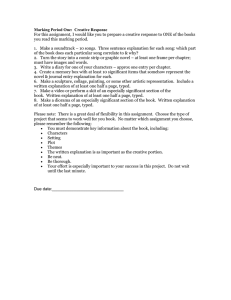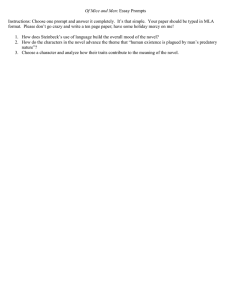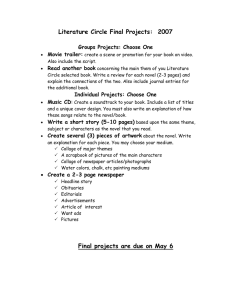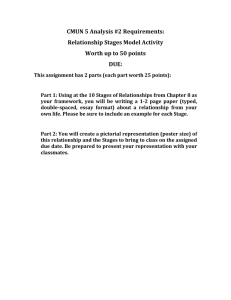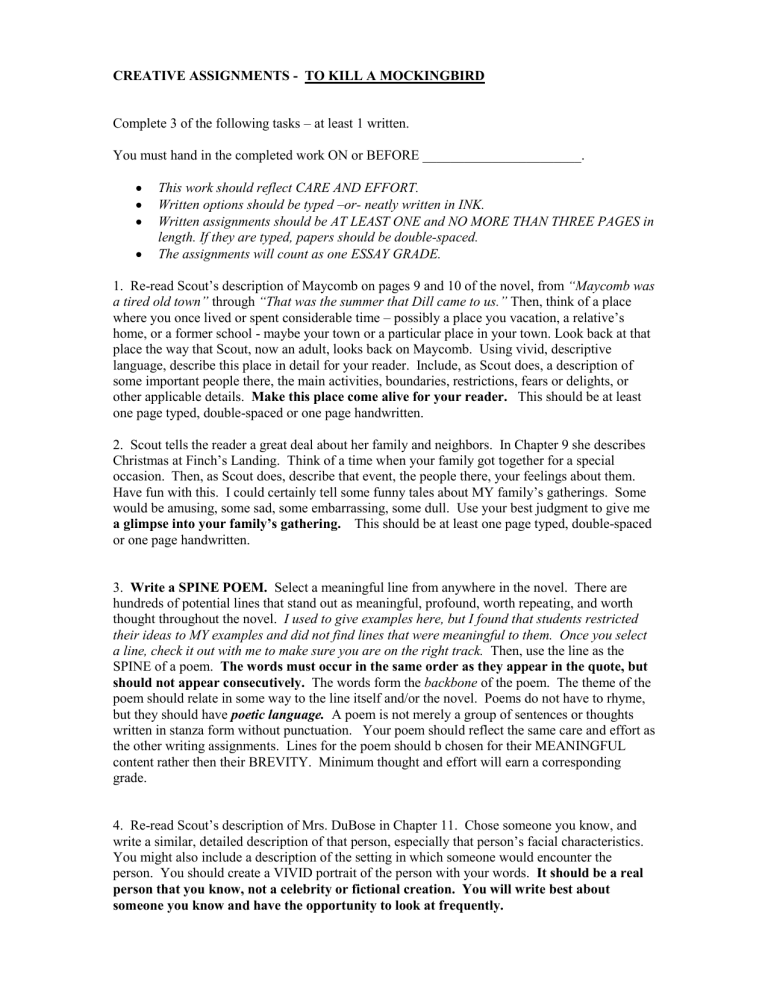
CREATIVE ASSIGNMENTS - TO KILL A MOCKINGBIRD Complete 3 of the following tasks – at least 1 written. You must hand in the completed work ON or BEFORE _______________________. This work should reflect CARE AND EFFORT. Written options should be typed –or- neatly written in INK. Written assignments should be AT LEAST ONE and NO MORE THAN THREE PAGES in length. If they are typed, papers should be double-spaced. The assignments will count as one ESSAY GRADE. 1. Re-read Scout’s description of Maycomb on pages 9 and 10 of the novel, from “Maycomb was a tired old town” through “That was the summer that Dill came to us.” Then, think of a place where you once lived or spent considerable time – possibly a place you vacation, a relative’s home, or a former school - maybe your town or a particular place in your town. Look back at that place the way that Scout, now an adult, looks back on Maycomb. Using vivid, descriptive language, describe this place in detail for your reader. Include, as Scout does, a description of some important people there, the main activities, boundaries, restrictions, fears or delights, or other applicable details. Make this place come alive for your reader. This should be at least one page typed, double-spaced or one page handwritten. 2. Scout tells the reader a great deal about her family and neighbors. In Chapter 9 she describes Christmas at Finch’s Landing. Think of a time when your family got together for a special occasion. Then, as Scout does, describe that event, the people there, your feelings about them. Have fun with this. I could certainly tell some funny tales about MY family’s gatherings. Some would be amusing, some sad, some embarrassing, some dull. Use your best judgment to give me a glimpse into your family’s gathering. This should be at least one page typed, double-spaced or one page handwritten. 3. Write a SPINE POEM. Select a meaningful line from anywhere in the novel. There are hundreds of potential lines that stand out as meaningful, profound, worth repeating, and worth thought throughout the novel. I used to give examples here, but I found that students restricted their ideas to MY examples and did not find lines that were meaningful to them. Once you select a line, check it out with me to make sure you are on the right track. Then, use the line as the SPINE of a poem. The words must occur in the same order as they appear in the quote, but should not appear consecutively. The words form the backbone of the poem. The theme of the poem should relate in some way to the line itself and/or the novel. Poems do not have to rhyme, but they should have poetic language. A poem is not merely a group of sentences or thoughts written in stanza form without punctuation. Your poem should reflect the same care and effort as the other writing assignments. Lines for the poem should b chosen for their MEANINGFUL content rather then their BREVITY. Minimum thought and effort will earn a corresponding grade. 4. Re-read Scout’s description of Mrs. DuBose in Chapter 11. Chose someone you know, and write a similar, detailed description of that person, especially that person’s facial characteristics. You might also include a description of the setting in which someone would encounter the person. You should create a VIVID portrait of the person with your words. It should be a real person that you know, not a celebrity or fictional creation. You will write best about someone you know and have the opportunity to look at frequently. 5. Make a connection between a theme of this novel and some other medium. Find another work, whether it is a movie, song, novel, work of art, or news story, and examine the similarities between the two. Your response should include SPECIFIC INFORMATION from both works. Include song lyrics, a movie, book, or news story summary (in your own words), a picture and explanation of the work of art, as well as direct comparisons of themes, characters, events, etc. Again, do not select this option because it is easy, because if it is done well, it is not easy. You should be able to draw many comparisons. I can give examples, but I fear you will select my song or art, and not your own. Not including the lyrics, this should be one page. 6. In Chapter 20, the jury hears Atticus’ summation speech – his final, powerful remarks which are a plea to find Tom Robinson NOT GUILTY. Re-read that speech. Because Scout is not in the courtroom to hear Mr. Gilmer’s final argument, readers do not learn the content of his closing statement. Pretend that YOU are Mr. Gilmer, the prosecuting attorney. Write the summation speech that you would give to convince the jury to find Tom Robinson guilty. I know that what you write is not an indication of your personal feelings. Write the speech as if you were Mr. Gilmer in Maycomb, Alabama in 1935. Stay “true” to the character of Mr. Gilmer, and try to make his words as powerfully convincing as those of Atticus. 7. Writer’s Choice: Do you have an idea for something you would like to write? If so, create the assignment. Put it in writing so that you and I are both clear about what you will do. Maybe you want to re-write a scene from another character’s point of view – What did Boo Radley see through the window? What was Lula thinking? What was Miss Maudie really feeling as she watched her house burn or as she cleaned up the mess afterwards. Make me an offer for a written response that I have not thought of. CREATIVE RESPONSES: 1. Are you ARTISTIC? Create a drawing of some aspect of the novel that comes alive for you. According to the novel’s description, draw the Radley Place or the Ewell’s house. Draw the Negro Cabins and the turn around there. Draw a particular scene that comes alive for you. Be sure that your drawing depicts the person, place, or thing as Scout describes it. Beneath your picture include: A quotation from the novel which refers to your picture. The page number(s) where the description of your picture can be found. 2. To Kill a Mockingbird shows many times that a person’s outward appearance often disguises his/her true inner qualities. Using a small paper bag, box, or a poster, create a collage that depicts your outer appearance on the outside (or on one side, in the case of a poster). Attach photographs, artifacts, words, that are fairly “common knowledge” about you. The “you” that is known by most people. Then, inside the box, bag, or the other side of the poster, place the photos, artifacts, words, that reveal “the inner you.” You need not reveal any deep, dark secrets, but perhaps things that not many people know about you. Use your judgment regarding what is school appropriate. Include with the paper bag, a typed up report explaining the things on the inside and outside of the bag. 3. Come to class dressed as a character from the novel. Write a short essay, ¾ of a page typed, describing that character. Make a presentation to the class about your character. 4. Collage: On a sheet of poster board, make a collage that represents a theme, character, or an event in the story. The collage should have attached a paragraph explaining the theme, character, or event that you have visually presented in your collage.
